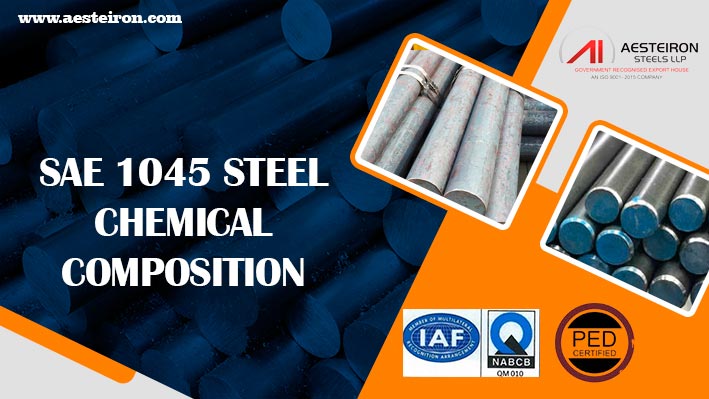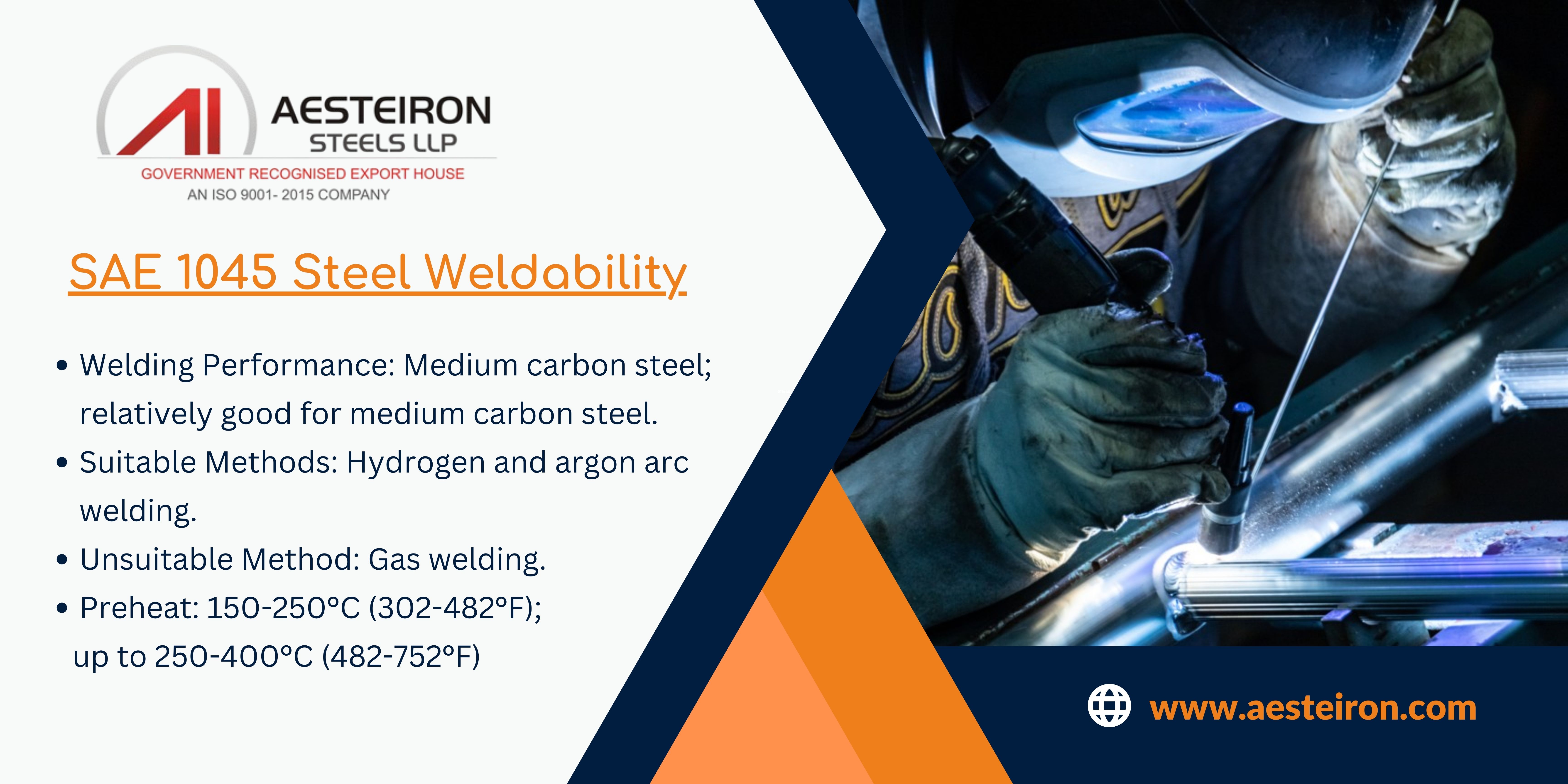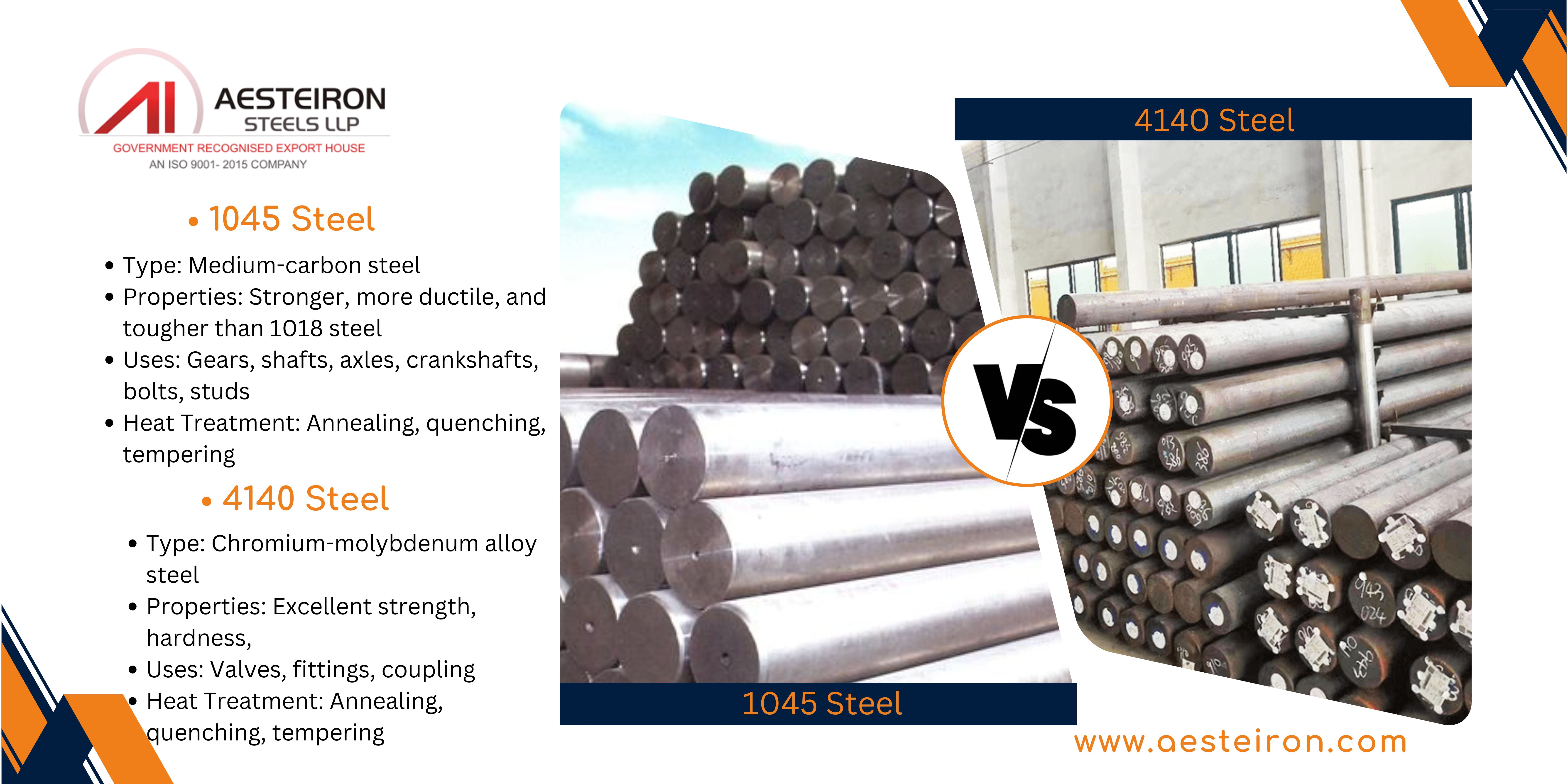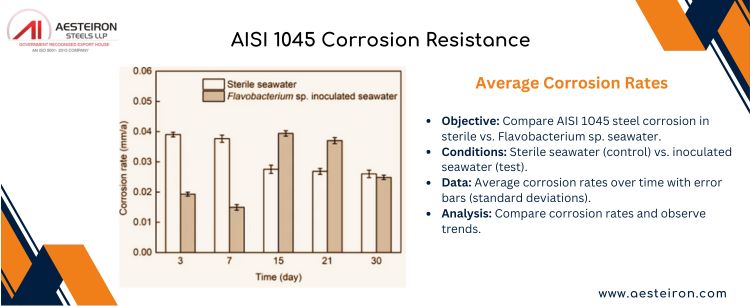SAE 1045 Steel Chemical Composition

Understanding the chemical composition of SAE 1045 steel is essential because it directly influences its mechanical properties. The table below provides a detailed overview of the chemical makeup of this popular carbon steel grade.
Table of contents
- SAE 1045 Steel Chemical Composition
- ASTM 1045 Weldability
- Mechanical Property of AISI 1045 Steel Cold Drawn
- Heat Treatment of DIN 1.1191
- 1045 Steel vs 4140 Steel
- 1045 Quenched and Tempered Steel properties
- AISI 1045 Equivalent Grades
- Thermal Properties of SAE 1045
- Tolerance of AISI 1045 Carbon Steel
- Ck45 Steel Annealing
- Quality Certification of Steel 1045
- AISI 1045 Corrosion Resistance
- Electrical Properties of JIS S45C Steel
- Applications of SAE 1045 Steel
SAE 1045 Steel Chemical Composition
| Grade | C | Si | Mn | P | S |
|---|---|---|---|---|---|
| 1045 | 0.43-0.50 | 0.15-0.35 | 0.60-0.90 | ≤0.04 | ≤0.05 |
AISI 1045 Offers Good Weldability, Machinability, and High Strength
AISI 1045 steel is known for its excellent weldability, which makes it ideal for creating strong, durable joints that can withstand structural stress. This property is especially important in applications where safety and performance are critical.
Its machinability is another key advantage, allowing for efficient cutting and shaping with minimal tool wear. This leads to better surface finishes, tighter tolerances, and faster production times, ultimately reducing manufacturing costs.
Additionally, the high strength of AISI 1045 makes it suitable for use in heavy-duty structures and components that must endure high loads and harsh environmental conditions.
AWS 1045 Weldability

| Aspect | Details |
|---|---|
| Welding Conditions | AISI 1045 is readily welded with the correct procedure |
| Electrodes | Use low hydrogen electrodes. |
| Pre-heating | Pre-heat workpiece to 200°C – 300°C (392°F – 572°F). |
| Welding Temperature | Maintain pre-heat temperature during welding. |
| Cooling | Cool slowly using sand or ashes to control the cooling rate. |
| Stress Relief | Perform stress relief at 550°C – 660°C (1022°F – 1220°F). |
Mechanical Properties of AISI 1045 Cold Drawn Steel
| Mechanical Properties | Hardness, (Brinell hardness) | Hardness, Brinell | Hardness, Rockwell B (Brinell hardness) | Hardness, Vickers ( Brinell hardness) | Tensile Strength, Yield | Tensile Strength, Ultimate | Elongation at Break (in 50 mm) | Reduction of Area | Poissons Ratio (Typical For Steel) | Modulus of Elasticity (Typical for steel) | Bulk Modulus (Typical for steel) | Shear Modulus (Typical for steel) |
|---|---|---|---|---|---|---|---|---|---|---|---|---|
| Metric | 184 | 163 | 84 | 170 | 310 MPa | 565 MPa | 16.00% | 40.00% | 0.29 | 200 GPa | 140 GPa | 80 GPa |
| Imperial | 184 | 163 | 84 | 170 | 45000 psi | 81900 psi | 16.00% | 40.00% | 0.29 | 29000 ksi | 20300 ksi | 11600 ksi |
DIN 1.1191 Material Are Generally Available in Black Hot Rolled or Normalized Conditions
The normalized condition improves the material’s structure and properties by enhancing mechanical performance, reducing internal stresses, improving machinability, and refining grain structure. This makes it more suitable for various engineering applications.
Heat Treatment of DIN 1.1191
| Process | Heating Temperature | Cooling Method |
|---|---|---|
| Forging | 850°C – 1250°C (1562°F – 2282°F) | Cool in a furnace |
| Annealing | 800°C – 850°C (1472°F – 1562°F) | Cool in a furnace |
| Normalizing | 870°C – 920°C (1598°F – 1688°F) | Cool in still air |
| Stress-Relieving | 550°C – 660°C (1022°F – 1220°F) | Cool in still air |
| Hardening | 820°C – 850°C (1508°F – 1562°F) | Quench in water or brine |
| Tempering | 400°C – 650°C (752°F – 1202°F) | Cool in still air |
1045 Steel vs 4140 Steel

| Property | 1045 Steel | 4140 Steel |
|---|---|---|
| Type | Carbon steel | Alloy steel |
| Carbon Content | 0.43-0.50% | 0.40% |
| Manganese Content | 0.60-0.90% | 0.75-1.00% |
| Chromium | None | Present |
| Molybdenum | None | Present |
| Iron (Fe) | 98.51-98.98% | 96.79-97.78% |
| Phosphorus (P, max) | 0.04% | 0.035% |
| Sulfur (S, max) | 0.05% | 0.040% |
| Strength | Good strength and impact resistance | Superior hardness and toughness |
| Common Uses | Machinery parts, automotive components | Axles, gears, shafts |
| Characteristics | Moderate hardness and strength | Enhanced wear resistance and toughness |
1045 Quenched and Tempered Steel Properties
| Section size mm | up to 16mm | 17-44 mm | 41-100 mm |
|---|---|---|---|
| Tensile strength Mpa | 700-850 | |650-800 | 630-780 |
| Yield strength Mpa | 500 | 430 | 370 |
| Impact Charpy | 30 | 30 | 30 |
| Elongationin 50mm % | 14 | 16 | 7 |
| Hardness HB | 210-245 | 195-235 | |185-230 |
Equivalent Grades of AISI 1045 Steel
Understanding equivalent grades of AISI 1045 is helpful when working with international standards. Below is a list of equivalent grades from different countries:
AISI 1045 Equivalent Grades
| Country | USA | British | Japan | Australia |
|---|---|---|---|---|
| Standard | ASTM A29 | EN 10083-2 | JIS G051 | AS 1442 |
| Grades | 1045 | C45/1.1191 | S45C | 1045 |
Thermal Properties of SAE 1045
| Properties | Metric | Imperial |
|---|---|---|
| Thermal conductivity | 51.9 W/mK | 360 BTU in/hr.ft2.°F |
| Thermal expansion co-efficient (@0.000-100°C/32-212°F) | 11.2 µm/m°C | 6.22 µm/m°C |
Tolerance of AISI 1045 Carbon Steel
| Surface Finish | Black-Forged | Turned | Black-Rolled | Peeled | Grinding | Polished | Cold Drawn |
|---|---|---|---|---|---|---|---|
| Tolerance | (0,+5mm) | (0,+3mm) | (0,+1mm) | Best H11 | Best h9 | Best h11 | Best H11 |
Annealing of Ck45 Steel
Annealing Ck45 steel at around 820–840°C helps to reduce hardness and improve machinability. After annealing, the material is cooled gradually to achieve the desired mechanical properties for specific applications.
Ck45 Steel Annealing
| Aspect | Details |
|---|---|
| Purpose of Annealing | Softens surface hardness for improved machinability |
| Annealing Temperature | 820°C to 840°C |
| Holding Time | Sufficient time at annealing temperature |
| Measured Surface Hardness | Typically below 200 HBW (Brinell Hardness) |
Quality Certification of AISI 1045 Steel
- Chemical analysis
- Ultrasonic test report
- Non Metallic Inclusion
- Heat Treatment Process
- Mechanical properties
- Surface hardness
- Grain size
- Forging ratio
AISI 1045 Has Low Corrosion Resistance
Due to its low chromium content, AISI 1045 steel is not highly resistant to corrosion, especially in acidic or saline environments. It may require protective coatings or treatments to prevent rust and degradation over time.

AISI 1045 Corrosion Resistance
| Feature | 1045 Steel |
|---|---|
| Primary Composition | 0.45% Carbon, Iron |
| Corrosion Resistance | Low |
| Protective Layer | Does not form a protective chromium oxide layer |
| Exposure to Harsh Environments | Prone to rust and corrosion in salt water, acids, and bases |
| Maintenance Requirements | Requires coating or treatment for better resistance |
| Typical Applications | Structural components, machinery, automotive parts |
Electrical Properties of JIS S45C Steel
| Electrical Properties | Metric | English | Comments |
|---|---|---|---|
| Electrical Resistivity | 0.0000162 ohm-cm Temperature 0.000 °C |
0.0000162 ohm-cm Temperature 32.0 °F |
annealed specimen |
| 0.0000223 ohm-cm Temperature 100 °C |
0.0000223 ohm-cm Temperature 212 °F |
annealed specimen |
Applications of SAE 1045 Steel
| Pins | Gears | Rams |
| Ratchets | Bolts | Light gears |
| Rolls | Shafts | Sockets |
| Spindles | Axles | Worms |
| Crankshafts | Studs | Guide rods |
| Torsion bars | Connecting rods | Hydraulic clamps |
Coalescing filter, coalescer and separator filter cartridge, coalescing air filter, coalescing gas filter, coalescing water filter
Xinxiang Zhike Machinery Equipment Co.Ltd , https://www.zhikefilter.com